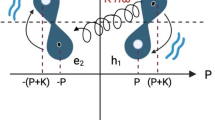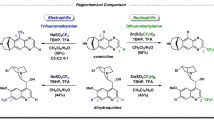Abstract
1 -ALKYL-2 - (α - HYDROXYBENZYL) - BENZIMIDAZOLES (I) give a high degree of protection against the cell degeneration which follows infection of tissue cultures with poliovirus (types 1, 2 and 3)1. The action of corresponding quaternary salts (II) is of considerable interest in view of: (a) the much greater solubility of these compounds in water; (b) the introduction of the positive charge; (c) the removal of the type of hydrogen-bonding (III) or metalchelating (IV) propensities that might (for example, by allowing attachment to protein or nucleic acid) play some part in the activity of the parent compound HBB (I; R = H) and of its 1-alkyl derivatives (I; R = alkyl). Infra-red spectra show that these latter compounds form pairs of intermolecular hydrogen-bonded links as indicated (III), and they also form copper chelates. 
This is a preview of subscription content, access via your institution
Access options
Subscribe to this journal
Receive 51 print issues and online access
$199.00 per year
only $3.90 per issue
Buy this article
- Purchase on Springer Link
- Instant access to full article PDF
Prices may be subject to local taxes which are calculated during checkout
Similar content being viewed by others
References
O'Sullivan, D. G., and Wallis, A. K., Nature., 198, 1270 (1963).
Author information
Authors and Affiliations
Rights and permissions
About this article
Cite this article
O'SULLIVAN, D., WALLIS, A. 2-(α-Hydroxybenzyl)-benzimidazolium Salts and their Influence on Cultured Cells infected with Poliovirus. Nature 200, 1101–1103 (1963). https://doi.org/10.1038/2001101b0
Issue Date:
DOI: https://doi.org/10.1038/2001101b0
This article is cited by
-
Synthesis and Antimicrobial, Antiprotozoal, and Fungistatic Activity of [5-(Amino-, Acylamino-, and 2-Pyridylmethylamino)-1-Alkylbenzimidazol-2-yl]Diphenylmethanols
Pharmaceutical Chemistry Journal (2018)
-
Protection Offered to Poliovirus-Infected Tissue-Culture Cells by Methoxy- and Hydroxy-Methyl Compounds Related to 2-Benzylbenzimidazole
Nature (1965)
-
Action of D-1-Alkyl-2-(α-Hydroxybenzyl)-Benzimidazoles on Tissue-Culture Cells Infected with Poliovirus
Nature (1964)
Comments
By submitting a comment you agree to abide by our Terms and Community Guidelines. If you find something abusive or that does not comply with our terms or guidelines please flag it as inappropriate.



